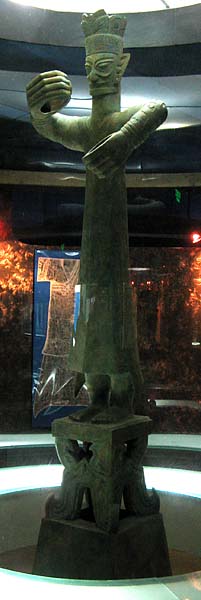This is the standing male figure from pit 2 is from Sanxingdui, China around 1200- 1050 BCE. The figure stands at about 8.5 feet high on a pedestal and was originally holding an elephant tusk. The statue wears three layers of robes, the outermost robe is decorated with shallow designs that have been interpreted as dragon motifs. The crown and the headdress bears a sun design. The dragon robe, sun crown, and pedestal suggests that the figure is royal. It can also be interpreted as a god, a priest king, or even a god king. The statue might have been offering the elephant tusk to the gods or carrying it as a symbol of authority. When the statue was first new it would look golden.
This is the fang ding from the tomb of lady Hao in 1200 BCE during the Shang Dynasty. This bronze vessel was connected with rituals and served as offering for food and wine. This was buried with its owner when she died. This is a square vessel with four legs and is one of the largest of its kind found in royal tombs. This was decorated with intricate images of animals such as birds, dragons, etc. There is a stylized face on each side and the legs, this face is a taotie mask which represents the Chinese god of greed and power. This was believed to have protected the owner from enemies and instill him with power and strength.









